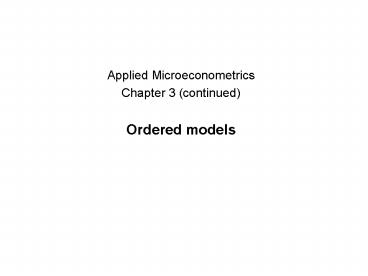Applied Microeconometrics Chapter 3 continued Ordered models PowerPoint PPT Presentation
1 / 8
Title: Applied Microeconometrics Chapter 3 continued Ordered models
1
Applied MicroeconometricsChapter 3
(continued)Ordered models
2
Making the right decision between alternative
models
yes
mlogit
IIA valid ?
unordered
no
mprobit nested logit
ordered logit/ probit
ordered
IIAindependence of irrelevant alternatives
(assumption)
3
Ordered models
Example for ordered structure Observed dependent
variable yi contains m categories such as
educational outcomes (basic schooling, completed
apprenticeship, A-levels, university degree etc.)
Latent model is linear, e.g. where yi is the
amount of education sought and xi could be
variables such as abilities, parents education
and income, distance to city etc. Note that xi
does not contain an intercept (well see shortly
why not).
4
Observed and latent outcomes
Define a series of threshold values
a1,,am-1 Category j is chosen if so that in
analogy to the binary model
5
Estimation by ML
Suppose that ei is distributed standard
normal. Then the log likelihood function is
where The log likelihod function is then
maximised with respect to a1,,am-1 and ß.
6
Example
- Choice of voting alternatives by ILO delegates
- coding yes 2, abstention 1, no 0
- explanatory variables GDP, Govt CEOs party
affiliation
. oprob newvote ceo_left ceo_cent ceo_righ
income2 income3 income4 income5 Iteration 0
log likelihood -2090.4973 Iteration 1 log
likelihood -2040.3852 Iteration 2 log
likelihood -2040.3438 Iteration 3 log
likelihood -2040.3438 Ordered probit
regression Number of obs
2103
LR chi2(7) 100.31
Prob gt
chi2 0.0000 Log likelihood -2040.3438
Pseudo R2
0.0240 ------------------------------------------
------------------------------------ newvote
Coef. Std. Err. z Pgtz 95
Conf. Interval ---------------------------------
--------------------------------------------
ceo_left .2443465 .0660788 3.70 0.000
.1148343 .3738586 ceo_cent
.038681 .1267729 0.31 0.760 -.2097893
.2871514 ceo_righ -.361733 .0716722
-5.05 0.000 -.502208 -.221258
income2 .2484576 .0818912 3.03 0.002
.0879538 .4089615 income3 .2016928
.0810596 2.49 0.013 .0428189
.3605666 income4 .2825082 .0778242
3.63 0.000 .1299755 .4350408
income5 -.1632577 .1101756 -1.48 0.138
-.3791979 .0526826 -------------------------
--------------------------------------------------
-- /cut1 -.0628592 .0603017
-.1810484 .0553301 /cut2
.2865001 .0604946 .1679328
.4050675 --------------------------------------
----------------------------------------
7
Marginal effects
- Marginal effects can be calculated as the
marginal effect of choosing category j - Example
gen marg_left_yes _bceo_left
(normalden(_b/cut2- xb)) gen marg_left_abst
_bceo_left (normalden(_b/cut1-
xb)-normalden(_b/cut2- xb)) gen marg_left_no
-_bceo_left (normalden(_b/cut1- xb)) su
marg_left Variable Obs Mean
Std. Dev. Min Max -----------------
--------------------------------------------------
-- marg_left_s 2103 .0932732
.0053666 .0701328 .0974801 marg_left_t
2103 -.0008502 .0081877 -.0127827
.0174747 marg_left_no 2103 -.092423
.0054945 -.0974671 -.081922
8
Other issues
- Easy to verify that binary probit is a special
case of ordered probit (interpretation of
estimated threshold value?) - If ei is assumed to be distributed logistic
?ordered logit - As in the binary case, there is little
difference between logit and probit. Coefficient
magnitudes are not directly comparable. - Interval-coded data with underyling continuous
variable and known cutpoints (e.g., income
groups) similar procedure, but thresholds are
not estimated - Extensions Generalized ordered outcome models

